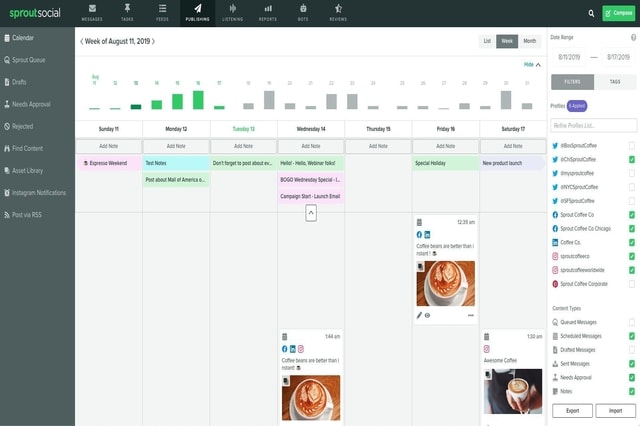How to Create an Effective Social Media Campaign for Your Business?

Social media – two words that have been restlessly dominating the marketing industry for quite some time. While social media marketing has reached its peak in the last couple of years, it is no novelty. Businesses have been using social media as a marketing tool since the early 2000s.
Back in the day, social media was the choice of few innovative and forward-thinking brands. Nowadays, creating social media campaigns is practically a must.
If you want to improve brand awareness, reach new audiences, drive organic traffic to your website, and build social proof, the solution lies in social media marketing.
Just consider the following statistics:
- Over 80% of US adults aged between 18 and 49 years are active social media users.
- 73% of marketers have expressed that social media has been an effective marketing channel.
- 54% of social browsers turn to social media to get more information on the products.
- A positive brand experience on social media motivates 71% of consumers to recommend that brand to their family and friends.
The case is clear – social media marketing works. What’s more, people have gotten used to learning about brands and products through social media campaigns. They expect brands to have a strong social presence.
To make social media your key marketing player, you need to create effective campaigns. Competition is fierce, so proper strategy and thought-out plan are very much needed.
Building a social media marketing campaign will ensure that you have proper guidelines for achieving your marketing goals. So, without further ado, here are the key steps that will lead you to the campaign your business needs.
1. Set Your Campaign Goals
Every plan must have an end goal. So, the imposed question is what you want to achieve with your campaign?
The goals of your social media campaign define your strategy. They also allow you to set metrics based on which you’ll measure your success.
Some goals you can set are:
- Generate new leads
- Increase sales
- Build brand awareness
- Promoting your new collection/product/service
However, simply writing down a general goal won’t motivate success. What you need is to make your goals SMART.
SMART goals need to be:
- Specific
- Measurable
- Attainable
- Relevant
- Time-bound
Therefore, the way you should describe your goals looks something like this:
Build brand awareness by increasing the number of followers on Instagram to 15,000 until September.
2. Gather Data on Your Target Audience
Since you are designing the campaign to win over the audience, you need to know who they are and what they want.
If you already have the statistics on your target audience, that’s a good start. Use that information as a foundation and then dig deeper.
Pause: If you are planning on setting up your limited liability company in California, then read about how to set up LLC in California.
You want to look beyond the typical demographics such as age, gender, location, and so on. What should also interest you is:
- The target audience’s preferences
- Current trends among your target audience
- Type of content they prefer
- Target audience’s pain points
- Target audience’s purchasing habits
Get a complete picture of who they are, what they like, what excites them, and what they dislike. The more you know, you’ll be able to create a more personalized and successful campaign.
3. Get to Know Your Competitors
Your competitors can teach you a lot. Their hits and misses can help you understand the dos and don’ts of social media marketing for your target audience. Since you aim to attract and charm the same people, information on their practices can give you some pointers.
Check the social media activities of your main competitors.
For example, you can use social listening to track when consumers mention the competitor’s brand name or product. Thus, you’ll have the data on what kind of content or activity provokes consumers to engage with the competitors.
Pay attention to:
- The channels your competitors use
- Which of their content gains the most engagement
- What are the social media tactics of the best brands in your niche
- If there is a type of content that provokes a negative response
To help you grasp the importance of competitors’ analysis, let us provide you with an example.
Imagine that you’ve researched your competitors’ activities and noticed that they all have a strong presence on Instagram, but scarce activity on Facebook. You also noticed that the content they do post on Facebook gets decent engagement.
According to these findings, you can make a strong campaign for Facebook. The research has shown you that there is a scarcity of quality and frequent content on this platform. This will allow you to dominate Facebook and win over the majority of the audience.
4. Decide on the Social Media Channels You’ll Use
Depending on your past relationship with social media, you’ll have less or more work to do on social media platforms.
If you don’t have social media accounts set in place, now is the time to do it. Based on your research on the target audience, activate accounts that will put you on consumers’ radars.
However, if you do have active accounts with a regular online presence, you should rethink whether there is room for improvement.
Consider what type of campaign you’ll build and how your current accounts fit into the picture.
What you should take into account when it comes to social media platforms is:
- The preferred channels of your target audience
- The topic of your campaign and where you can present it best
- The content you want to create and publish
Let’s say that you currently run your campaigns on Facebook and Instagram. But, for the new campaign, you’re targeting the people in the world of business. This can call for a LinkedIn account. You might need to get acquainted with a new platform and create a LinkedIn profile bio if the campaign demands it.
Choose your channels wisely if you want to maximize the effect of the campaign.
5. Outline Key Ideas
The most creative part of creating a social media campaign is deciding on how you’ll make an impression on the audience. You need to brainstorm and outline what kind of content or activity will be present within your campaign.
Some aspects of the campaign you want to define are:
- Campaign’s message
- Theme
- Forms of content you’ll focus on (photo, video, live-streaming, etc.)
- How you plan to encourage engagement
Think about different forms of interaction with consumers like publishing user-generated content, influencer collaboration, giveaways, and so on.
This is the segment where you want to consult your team. Discuss with your writers, designers, and marketers what resources are available and what your best options are.
6. Create a Social Media Calendar
Social media calendar is the essence of an organized and streamlined campaign.
The benefits of using a social media calendar for your campaigns are:
- Save time
- Ensure consistency
- Reduce the chance of mistakes
- Have a clear overview of your strategy
- Keep your team organized
- Don’t forget about relevant dates
Use the calendar to pre-plan what type of content you want to post and when. The birds-eye-view will help you be more realistic about the deadlines. It will also help you balance the content you publish.
For example, if you want to mix brand-related content with informative and entertaining content, the calendar is where you’ll put down this strategy.
Not to mention that better organization and timely task delegation will allow you to create high-quality content. There will be no last-minute messy posts when the calendar has it all written out
In addition, the social media calendar can be used to streamline publishing. Turn to the calendar as a reference to see when you should create and schedule the content. Therefore, your team can keep up with their responsibilities.
You can use Microsoft Excel to create the calendar, or you can use specific tools. To help you visualize how social calendars look like, here’s an example of Sprout Social’s social media calendar:

7. Employ the Right Social Media Marketing Tools
Social media marketing tools are designed to help you handle the campaign more easily. They can streamline repetitive processes, save you time, and ensure that your content rises to the expectations.
If you don’t know what kind of tools you can employ, here are some suggestions:
- To streamline managing your campaigns – Buffer
- To analyze your target audience and their behaviors – SocialBakers
- For social listening – BrandMentions
- For scheduling posts for publishing – SproutSocial
- To create stunning visuals – Canva
- To create attractive videos – Animoto
These are just some examples to show you how the technology can assist you with various parts of your campaign. However, you can do your research and put together your ideal toolbox.
Most social media marketing tools have free trials, so you can give them a test run before you commit.
8. Measure the Performance
Even when you create the campaign and put it in motion, the work is not done. For your social media marketing efforts to be successful, you need to measure the campaigns’ performance.
Keep an eye on the response your campaign evoked and how it progresses. If you notice that some actions outperform others, you can adapt the campaign to go in that direction.
For example, if your video content has 40% higher engagement than visuals, you should review the various social media video formats and tailor the campaign to include more native video content.”
You need to regularly collect and analyze the data. They are the solution to improving your campaigns and increasing their success.
Final Thoughts
Social media marketing campaigns that bring results can’t be created overnight. They demand thought, effort, and time. However, the impact of such strategic campaigns is what makes it all worth it.
Therefore, if you want to create an effective social media marketing campaign, you know what you need to do. You have the receipt and the ingredients. Now just follow the steps, and you’ll reach your goal.




